Moeen Ali hit four sixes in England’s last ball victory over South Africa in Durban. Because he’s Moeen Ali and hasn’t even heard of ugly batting, each and every one of them was a languid, spaghetti-armed thing of wonder.
In all, Moeen hit seven lovely boundaries in his 11-ball innings. Being as the last of those 11 deliveries resulted in his dismissal, this means that Moeen hit 70 per cent of his non-terminal shots for a lovely boundary, which is an unusually high proportion.
One boundary was more lovely than the others though and it was the one that was a very obvious mishit.
Having made 25 off seven balls, Moeen went after a wide one.
Here he is, feet planted in the wrong spot, stretching for it.
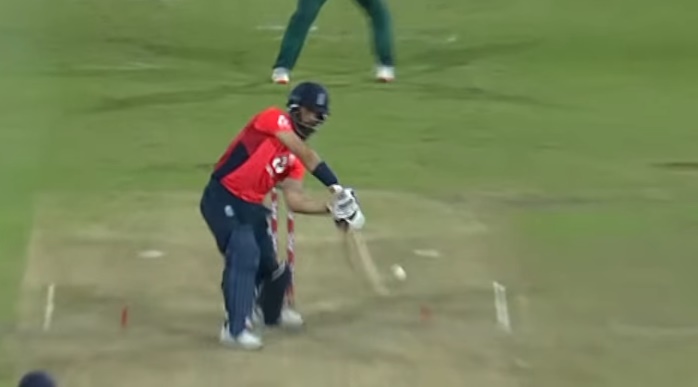
You’ll note that as Moeen was entirely aware that this wasn’t an optimal position from which to play the stroke, he ensured he was moving enough that the image would be very blurry so that he couldn’t be identified.
That could be anyone. Maybe it’s Danny Dyer. (It isn’t. It’s Moeen Ali.)
Now here’s a smudgy line that tells you where the ball went.
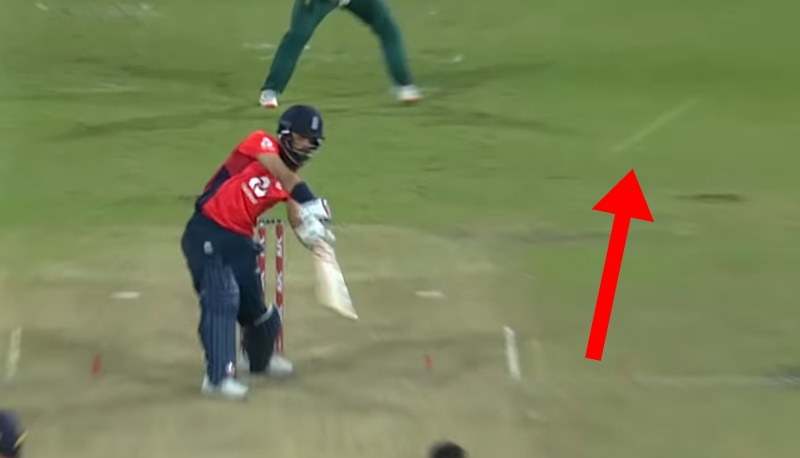
And now here’s Moeen’s completely normal follow-through for a ball that went where this one did.
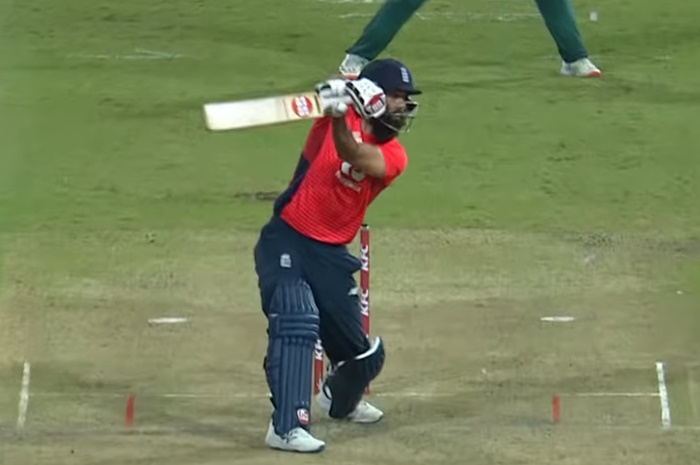
So obviously Moeen didn’t hit the ball very well.
He hit it badly, if we’re honest. He mishit it.
Moeen sliced the ball very gravely.
He delivered, at best, a glancing blow.
And this is where the ball went.

If you’re wondering where this is, we can assure you that it’s still Durban because that’s Kingsmead’s giant KFC bucket on the right.
The ball landed among children and drunk people and both groups were very visibly excited about the sudden presence of the spherical interloper.
The shot resulted in six runs being added to Moeen’s score. We’d argue that even though it was a mistake, it deserved more.
It’s like Bob Ross always used to say: there’s no such thing as mistakes, only happy accidents.
We’re not exactly sure how the one Moeen scooped to long-on shortly afterwards would fit into Bob Ross’s world view. We suppose you could argue it made some people happy.

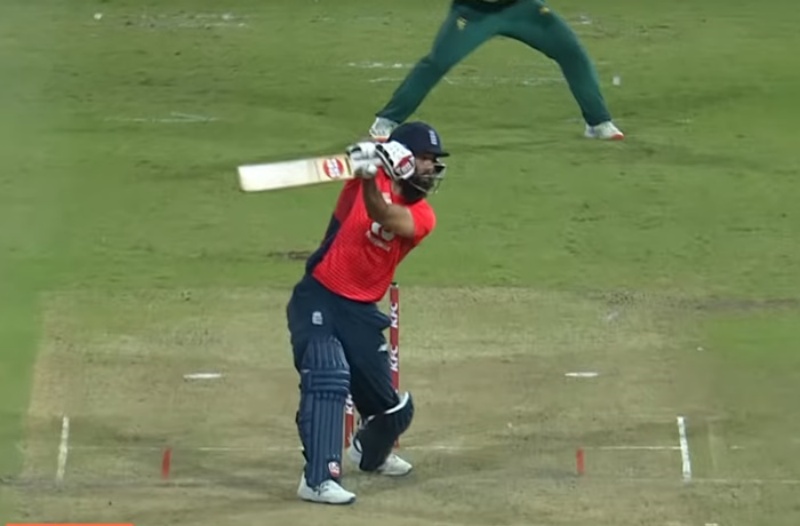

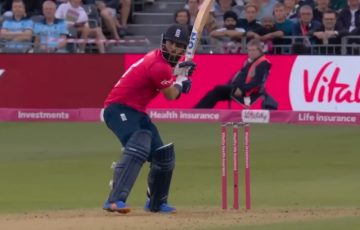
I was hoping to spot ‘bethwart’ somewhere in this article. A little disappointed, to be honest.
So are we now that you’ve reminded us.
Good times:
https://www.kingcricket.co.uk/tag/cricket-school/
I’ve just bought a couple of text books on real tennis technique and tactics. I have only dipped so far, but they both read very much like your cricket school series.
I’ll look out for bethwart-type phrases and report back.
Apologies if I have mentioned this before, but the habit headline writers on websites have of using the construction “[team] chase [total] for victory” to mean “[team] are chasing [total] in order to win” but also sometimes “[team] have successfully chased [total] and therefore won” is a bit annoying.
The BBC Sport live text coverage seems to be particularly egregious offender.
*a particularly egregious offender
Ah, simply delightful
A cricket article with Bob Ross in it. 10/10
I had the misfortune to be listening to Talksport on the wireless while driving home from work, during this innings. I’m afraid Alex Tudor’s commentary is not my cup of tea.
It is interesting how words can go around and come back.
I think of the term “wireless”, meaning “radio”, to be as old-fashioned a term as possible. It was my grandmother’s term for it. It is Private Eye’s spoof of Prince
Charles in the bath, mistaking something-or-other he hears on the wireless for the news that he is now King.
Yet, when it comes to Talksport 2, a channel only available through the internet, I suppose the term “radio” is the out of date term, whereas wireless describes the type of internet connection that most would use to receive the channel.
And yet, a cup of tea is still a cup of tea is still a cup of tea.
What is the topic we were supposedly talking about?
Is it though? In my house we now drink e-tea. No, not the alien from the film ET who I hoped would die throughout, along with Eliot and all the others, so I could stop watching. E-tea.
The tea we drink these days is a long way from the sort of tea your grandmother would have listened to on the wireless. For a start it contains electrons, which hadn’t been invented back then. We also have an entirely wire-free method of drinking it, obviously apart from the wires suspending the drinker from the ceiling. No electricity passes backwards or forwards through either the cup or the transmitter, something that would have been unheard of in your granny’s day.
At the flick of a knob we can switch between the Light Tea and the Home Tea, depending on how we are feeling. No doubt your gran would have had a servant to operate the remote control fastened to the front of the teapot. Drinking time back then would have been several hours, with the subject having to remain perfectly still throughout. Now it’s all over in less than a billionth of a second.
So while on the surface, your cup of tea is the same as your G’s electro-receptionator, underneath it’s a whole new ball game, just like T20.
Hmmm, you still seem to think I come from some sort of noble stock, Bert, despite my presentation of evidence to the contrary.
Nothing could be further from the truth.
My maternal grandmother was, coincidentally, in the tea business; she was a nippy in a Lyons Tea House, although her career there was so far back in the mists of time (over 100 years ago), she was probably referred to as a Gladys:
https://en.wikipedia.org/wiki/Nippy
I have it on good authority that some of the nippies (Gladyses) were so quick that they could accelerate particles of tea to speeds at which subatomic particles of tea might emerge upon collision. This assertion has never been proved, but nor has it been disproved.
Sadly, I never met that grandmother, but I suspect I would have had trouble facing her cinnamon ball if she had bowled it at me at pace off her full run when she was still in the bloom of her youth.
So I hadn’t watched much T20 before this series, and managed to catch most of the first game and all of the second and third. None of my American friends can be said to give what one might describe as “a fuck” about cricket, T20 or otherwise, so I briefly ramble here.
The zany shots are fun and different! Every ball does seem to matter in a way that it doesn’t in FC/50 over games, so it seems to hold my attention differently. I think I’ll keep watching the notable T20s. The T20 World Cup will be fun in its own way.
Some stuff bugs me about it though; from the mundane to the more notable. On the more mundane side, I find it bums me out that LBW shouts and wicket celebrations aren’t as visceral as in Tests. It doesn’t matter, really, but when it’s just Jos and Adil shouting for LBW it doesn’t seem as important.
On the more notable side, T20 seems to manufacture the same sort of closeness that basketball does. It’s not manufacturing truly close games, but some facsimile thereof. An NBA game with a 10-point difference between teams is mostly dull until the last two minutes or so. Then, a couple quick baskets by the team behind and, wouldn’t you know it, they’re in with a shout and we can all be excited. Far more often than not, the team that had the 10-point lead wins. T20 seems to have the same sort of faux-closeness. An over of 18-20 runs doesn’t seem that uncommon, and is more than enough to swing some hope in a losing effort, creating a faux sense of closeness.
T20 also shares with basketball the devaluing of the point/run, and dull tactics (the tactics point is very taste-dependent, of course).
Maybe I just haven’t seen enough T20. Maybe I’m just a curmudgeon who spotted a vague similarity to a sport I already dislike (basketball) and chose that as a vain effort to sound smart in my criticism. Who’s to say?
Interesting analysis.
We could have an intriguing debate about the definition of the word “faux” in this context.
DLS allows us to discern, with the backing of statistical and probabalistic evidence, just how close the ending might be. But only up to a point.
So when DLS suggests, say, that needing 5 runs off the last over is par, because the side batting second is already 9-down, then you know that their probabalistic chances are low, yet you also know that one big shot could win the match.
You also know who is actually batting and bowling in that actual game. If it is Ben Stokes and Mark Wood batting at 9-down, you know that there is a decent chance of them scoring quite a few runs. If it is Chris Martin and Alan Mullally, you are alreasy making a dash for the gate to avoid the crowds leaving the ground.
It also depends on who is bowling, of course.
The extreme assymetry of cricket and the “mini-battles within the main battle” that come from each “bowler on batsman” combination provides far more of interest, in my opinion, than seeing a symmetrical game like basketball pan out, in which, if one side has dominated the other for the first 90%-95% of the match, it is rare indeed for the side that is behind to turn such a position around and reverse it in the last few minutes.
But we have all seen one big over reverse a winning position in a T20 match. Not quite the 9-down scenario, but consider this famous example:
https://www.espncricinfo.com/series/8604/report/951373/england-vs-west-indies-final-world-t20-2015-16
Really interesting thoughts, and thought-provking, Robb.
Welcome home Robb, welcome home.